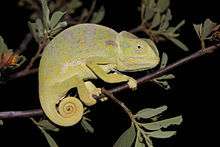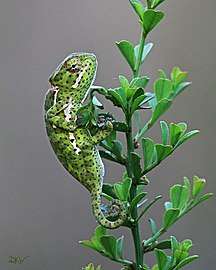Flap-necked chameleon
The flap-necked chameleon (Chamaeleo dilepis) is a species of arboreal chameleon, a lizard in the family Chamaeleonidae. The species is native to sub-Saharan Africa. There are eight recognized subspecies, including the nominotypical subspecies.
| Flap-necked chameleon | |
|---|---|
 | |
| South Africa | |
| Scientific classification | |
| Kingdom: | Animalia |
| Phylum: | Chordata |
| Class: | Reptilia |
| Order: | Squamata |
| Suborder: | Iguania |
| Family: | Chamaeleonidae |
| Genus: | Chamaeleo |
| Species: | C. dilepis |
| Binomial name | |
| Chamaeleo dilepis Leach, 1819 | |
| Synonyms[2] | |
|
(arranged in alphabetical order) | |
Subspecies
The following subspecies of the flap-necked chameleon are recognized as being valid.[2]
- Chamaeleo dilepis dilepis Leach, 1819 – flap-necked chameleon
- Chamaeleo dilepis idjwiensis Loveridge, 1942 – Idjwi Island flap-necked chameleon
- Chamaeleo dilepis isabellinus Günther, 1893 – Isabelline flap-necked chameleon
- Chamaeleo dilepis martensi Mertens, 1864 – Pemba Island flap-necked chameleon
- Chamaeleo dilepis petersii Gray, 1865 – Peters' flap-necked chameleon
- Chamaeleo dilepis quilensis Bocage, 1866
- Chamaeleo dilepis roperi Boulenger, 1890
- Chamaeleo dilepis ruspolii Boettger, 1893
Etymology
The subspecific name, roperi, is in honor of Mr. G.D. Trevor-Roper.[3]
The subspecific name, ruspolii, is in honor of Italian explorer Prince Eugenio Ruspoli.[3]
Description
Chamaeleo dilepis is a large chameleon, reaching a total length (including tail) of 35 cm (14 in). Colouring ranges through various shades of green, yellow, and brown. There is usually a pale stripe on the lower flanks and one to three pale patches higher on the flanks.[4]

_female.jpg) Juvenile female
Juvenile female
South Africa_female_2.jpg) Juvenile female
Juvenile female
South Africa
Geographic range and habitat
Chamaeleo dilepis has a very wide distribution, occurring throughout much of sub-Saharan Africa from as far north as Ethiopia and Somalia to a western extreme of Cameroon, and as far south as northern South Africa. It inhabits coastal forest, moist or dry savannah, woodland and bushy grasslands, and may also venture into rural and suburban areas.[1]
Ecology
The adult female flap-necked chameleon lays 10-40 eggs in a hole dug in soil. The eggs take 10–12 months to hatch. The diet of C. dilepis includes a variety of invertebrates, although large individuals may take geckos and other chameleons. The species is itself commonly preyed on by snakes such as the boomslang and the twig snake.[1]
Captivity
Chamaeleo dilepis does well in captivity. It is mostly active during the day. When this species is in captivity, it is very important to create an environment very much like its natural climate. It may be fed a diet including crickets, mealworms, wax worms, and other locally caught insects. Its estimated life expectancy is 5–8 years.[5]
Conservation
The flap-necked chameleon is in heavy demand for the international pet trade, being the third most highly traded chameleon species. More than 111,000 individuals were exported between 1977 and 2011, mostly to the USA. No detrimental effects on the total population size have been observed so far, although more in-depth studies have been recommended. The species is currently classified as Least Concern by the IUCN.[1]
References
- Tolley K (2014). "Chamaeleo dilepis ". IUCN Red List of Threatened Species. 2014: e.T176308A1438077. doi:10.2305/IUCN.UK.2014-3.RLTS.T176308A1438077.en.
- Species Chamaeleo dilepis at The Reptile Database www.reptile-database.org.
- Beolens, Bo; Watkins, Michael; Grayson, Michael (2011). The Eponym Dictionary of Reptiles. Baltimore: Johns Hopkins University Press. xiii + 296 pp. ISBN 978-1-4214-0135-5. (Chameleo roperi, p. 226; Chameleo ruspolii, p. 229).
- Tolley, Krystal; Burger, Marius (2007). Chameleons of Southern Africa. Cape Town, South Africa: Struik. 100 pp. ISBN 978-1770073753. (Chamaeleo dilepis, pp. 87-88).
- "Flap Necked Chameleon - Lizard Types". Lizard Types. Retrieved 20 April 2016.
Further reading
- Branch, Bill (2004). Field Guide to Snakes and other Reptiles of Southern Africa. Third Revised edition, Second impression. Sanibel Island, Florida: Ralph Curtis Books. 399 pp. ISBN 0-88359-042-5. (Chamaeleo dilepis, pp. 227-228 + Plate 96).
- Leach WE (1819). "Appendix. No. IV. Reptilia. (Reptiles.)" pp. 493-496. In: Bowdich TE (1819). Mission from Cape Coast Castle to Ashantee, with a Statistical Account of that Kingdom, and Geographical Notices of other Parts of the Interior of Africa. London: John Murray. viii + 512 pp. (Chamaeleo dilepis, new species, p. 493). (in English and Latin).
- Main DC, van Vuuren BJ, Tolley KA (2018). "Cryptic diversity in the common flap-necked chameleon Chamaeleo dilepis in South Africa". African Zoology 53 (3): 11-16.
- Reaney LT, Yee S, Losos JB, Whiting MJ (2012). "Ecology of the Flap-necked Chameleon Chamaeleo dilepis in Southern Africa". Breviora (532): 1-18.
- Reissig J, Boshoff D (2013). "Chamaeleo dilepis dilepis Leach, 1819, Common Flap-neck Chameleon, Reproduction". African Herp News, Newsletter of the Herpetological Association of Africa (59): 44-45.
| Wikimedia Commons has media related to Chamaeleo dilepis. |
